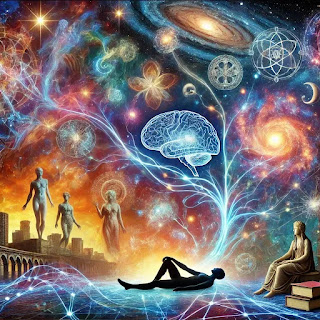How Nature Reacts to Human Activities!
Nature reacts to human activities in various ways, as these activities often disrupt ecological balance, contribute to environmental degradation, and impact biodiversity. Here's a detailed look at how nature responds to specific human activities:
1. Deforestation
Soil Erosion: Trees bind soil with their roots. When forests are cut down, soil becomes loose and is easily washed away by rain or wind, leading to erosion.
Loss of Biodiversity: Forests are home to countless species. Deforestation destroys habitats, causing species to either relocate, adapt, or face extinction.
Climate Change: Trees absorb carbon dioxide (CO2). When they are cut down, stored carbon is released back into the atmosphere, contributing to global warming.
Hydrological Cycle Disruption: Forests play a crucial role in the water cycle. Deforestation can reduce precipitation and affect water availability, potentially causing droughts.
2. Industrialization and Pollution
Air Pollution: Factories release large amounts of greenhouse gases (GHGs), including carbon dioxide, methane, and nitrous oxide, contributing to global warming and climate change.
Acid Rain: Emissions of sulfur dioxide (SO2) and nitrogen oxides (NOx) from industrial processes react with water in the atmosphere to form acid rain, which damages forests, soils, lakes, and aquatic life.
Water Pollution: Industrial waste, chemicals, and heavy metals pollute water bodies, harming aquatic ecosystems and making water unsafe for consumption.
Soil Contamination: Pesticides, fertilizers, and industrial chemicals seep into the ground, reducing soil fertility and affecting plant growth.
3. Agriculture
Land Degradation: Intensive farming practices, such as over-plowing and the excessive use of fertilizers and pesticides, degrade soil quality, leading to reduced crop yields and desertification.
Loss of Biodiversity: Monoculture farming reduces biodiversity, making ecosystems more vulnerable to pests and diseases.
Water Overuse: Agriculture is one of the largest consumers of freshwater. Over-irrigation leads to water scarcity, depleting rivers and aquifers.
Eutrophication: Excess fertilizers, especially nitrogen and phosphorus, run off into lakes and rivers, leading to algal blooms. These deplete oxygen levels in water, killing fish and other aquatic organisms.
4. Urbanization
Heat Islands: Cities, with their asphalt roads and concrete buildings, trap heat, creating "urban heat islands." This phenomenon increases local temperatures and energy consumption for cooling.
Habitat Fragmentation: Urban sprawl divides natural habitats, isolating wildlife populations and reducing biodiversity.
Flooding: Impervious surfaces in cities, such as roads and buildings, prevent water absorption, increasing runoff and the risk of floods.
Air and Noise Pollution: Urbanization increases emissions from vehicles, leading to air pollution, and industrial activities generate noise pollution, affecting human health and wildlife behavior.
5. Climate Change (Driven by Human Activity)
Rising Temperatures: Human activities, particularly burning fossil fuels, are leading to an increase in global temperatures. This warming causes glaciers to melt, sea levels to rise, and changes in weather patterns.
Extreme Weather Events: Climate change has led to more frequent and severe weather events, such as hurricanes, droughts, and floods, which disrupt ecosystems and human settlements.
Ocean Acidification: Increased CO2 absorption by oceans has led to acidification, which affects marine life, particularly coral reefs, shellfish, and plankton, the base of the marine food chain.
Loss of Arctic Ice: Warming temperatures are causing polar ice caps and glaciers to melt, affecting species like polar bears, penguins, and seals, and contributing to rising sea levels.
6. Overfishing
Fish Population Decline: Overfishing depletes fish populations faster than they can reproduce, threatening the survival of many species.
Disruption of Marine Ecosystems: Removing large numbers of fish affects predator-prey relationships and alters the balance of marine ecosystems, leading to the collapse of some fisheries.
Bycatch Issues: Many marine species, including dolphins, turtles, and seabirds, are caught unintentionally in fishing nets, leading to declines in non-target species populations.
7. Mining
Habitat Destruction: Mining activities clear large areas of land, destroying habitats and displacing wildlife.
Water Pollution: Chemicals used in mining operations, such as cyanide and mercury, can contaminate nearby water sources, affecting aquatic life and human populations dependent on clean water.
Air Pollution: Dust and emissions from mining activities contribute to air pollution, affecting the health of nearby communities and wildlife.
Soil Degradation: Mining disrupts soil structure and fertility, making it difficult for vegetation to regrow, leading to long-term land degradation.
8. Waste and Plastic Pollution
Marine Life Threats: Plastic waste in oceans is consumed by marine animals, leading to injury, starvation, and death. Micro-plastics also enter the food chain, affecting the health of both animals and humans.
Soil Contamination: Waste, especially non-biodegradable materials like plastic, can leach chemicals into the soil, affecting its quality and plant growth.
Air Pollution from Landfills: Decomposing waste in landfills releases methane, a potent greenhouse gas that contributes to climate change.
9. Use of Fossil Fuels
Global Warming: Burning fossil fuels releases carbon dioxide and other GHGs, which trap heat in the atmosphere, causing global temperatures to rise.
Ocean Warming: Warmer oceans lead to coral bleaching, disrupt marine life, and alter ocean currents, which in turn affect weather patterns.
Air Quality Deterioration: Fossil fuel combustion releases pollutants like nitrogen oxides and particulate matter, leading to smog, respiratory illnesses, and cardiovascular diseases in humans.
10. Introduction of Invasive Species
Biodiversity Loss: Human activities, such as trade and transportation, introduce non-native species into new environments. These invasive species often outcompete native species for resources, leading to declines in biodiversity.
Ecosystem Disruption: Invasive species can alter habitats, food webs, and ecological processes, sometimes leading to the collapse of ecosystems.
Conclusion:
Human activities have profound and often negative impacts on nature. While some of these impacts are reversible, many have long-term consequences that require urgent action. Sustainable practices, conservation efforts, and stricter environmental regulations are essential to mitigate these effects and restore the balance between human activity and natural ecosystems.




Comments